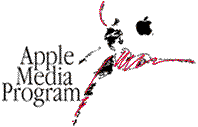New York, NY. As expected, IMA Expo’96 in New York is turning out to be the venue of choice for a number of major audio software introductions.
 Leading the parade today was Apple Computer Inc., which announced its Interactive Music Toolkit. Music Toolkit is a set of software tools for creating “Blue Book” enhanced audio CD’s (ECD’s). It is designed to allow audio producers, developers and artists to create multi-session ECD’s that can be played on both Mac and Windows platforms.
Leading the parade today was Apple Computer Inc., which announced its Interactive Music Toolkit. Music Toolkit is a set of software tools for creating “Blue Book” enhanced audio CD’s (ECD’s). It is designed to allow audio producers, developers and artists to create multi-session ECD’s that can be played on both Mac and Windows platforms.
“Apple has always been ahead of the curve when it comes to working with developers and artists,” said Leo Rossi, technical advisor for the EMI Record Group and principal of Highway One Media Entertainment. “The Music Toolkit allows the professional recording artist and developer to take the creative process to a new dimension.”
Music Toolkit ECDs are 16-bit audio CDs with added multimedia content. The multimedia materials can include graphics, pictures, lyrics, and QuickTime movies. The key component of Music Toolkit is a music engine for the Apple Media Tool. Media Tool is a high-end multimedia authoring environment which is used to assemble the interactive portion of the ECD. Also included is the Lyric Synchronizer utility, which synchronizes lyrics to the music.
In keeping with the corporate mandate to tout Internet applications before all else, Apple has focused attention on the Music Toolkit’s capability of creating “Virtual CD’s” (VCD). A VCD contains multimedia content without the audio. Users download a VCD from the Internet, put the appropriate audio CD in their computer’s CD-ROM drive, and the sound and multimedia content will play back simultaneously. Record companies can now add interactivity to audio CDs without having to produce a new version by posting the VCD file on their website.
The VCD feature is reminiscent of (but not identical to) a technology called CD-Link™ that multimedia publisher Voyager has been promoting for more than a year. CD-Link allows a downloadable file from the Internet to control playback of an audio CD, so that artists and end users may create edited versions of existing audio and synchronize the edits with web page text and graphics.
The Apple Interactive Music Toolkit is available for free download immediately at Apple’s web site. Also available there is the beta version of the AppleCD Player, which is required for playback of ECDs created with the Music Tool Kit.
The Toolkit requires a Mac, Power Mac or PowerBook computer with a 68030 processor or higher, running Mac OS 7.1 or later. 5MB RAM required, 12MB RAM recommended, and 10MB available disk space.